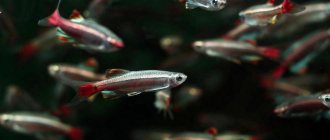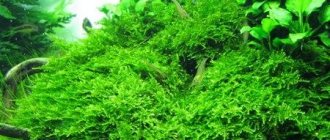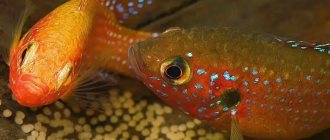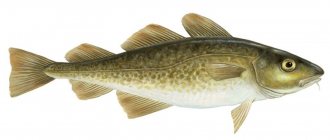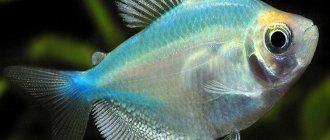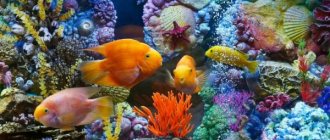Catfish and rules for keeping them
Catfish came to us from South America. These fish play the role of orderlies, eating up the remaining food from the bottom after other fish. Under natural conditions, they live in muddy ponds with standing water. Their food consists of larvae, worms, algae and decaying organic matter.
Catfish are unpretentious to the conditions in which they are kept. Even at the bottom of a dirty aquarium, these fish will feel great. They will help clean the walls of the aquarium and its bottom from food debris. The acidity and hardness of water does not matter for these fish.
Agamix
In nature, the length of the fish ranges from 15 to 17 cm, in an aquarium - up to 10 cm. It is a predator, therefore it needs protein food (bloodworms, tubifex, earthworms).
The singing catfish is capable of making loud sounds, which are a signal of danger or searching for a mate. In the aquarium it peacefully coexists with large fish; small ones can be used instead of food.
Ancistrus
Lovers of the home underwater world will appreciate the catfish with its eye-catching color and unusual suction cup mouth. Comfortable living conditions for ancistrus:
- water temperature from +20 to +28°C, a temporary decrease of 1-2 degrees will not affect the viability of the catfish;
- acidity from 6 to 7.5;
- spacious aquarium (over 80 l).
It is not recommended to add catfish to cichlids, as well as to clumsy fish. There have been cases when aquarium catfish chased other inhabitants and even spoiled their appearance.
Ancistrus is a bottom-dwelling fish, so it is necessary to provide some kind of shelter for it (a house, a snag). Catfish of this species feed on plant foods.
Dianema longybarbis
The fish is active not only at dusk. Swims in the lower and middle layers of water. Grows up to 7-8 cm. The fish loves live food. The bottom of the aquarium should be equipped with shelters and shady places in which the dianema will hide.
Speckled catfish
Corydoras is another name for the straw shell, native to South America. The first appearance of fish in the aquarium dates back to the beginning of the 20th century. The first fry were bred in 1870 in Paris by private aquarists. The Latin name of the fish means ashen skin.
Its bottom-dwelling lifestyle and easy-going nature make it possible to add catfish to any aquarium inhabitants. Dwarf catfish loves shaded places, snags, and shelters, so the bottom of the aquarium should be equipped with some kind of devices.
Cryptopterus Minor
The ghost catfish, or glass catfish, grows no more than 8 cm. This interesting fish eats food that slowly sinks to the bottom. It does not take food from the ground or surface; it feeds in the middle layers of water. Favorite food is daphnia and bloodworms.
In captivity, the transparent fish breeds reluctantly. To speed up this process, it is necessary to lower the water by 1-2 degrees. The usual temperature is 20-26°C, the volume of the aquarium is over 100 liters.
Sacbranch catfish
In an aquarium, the sacbranch catfish grows up to 30 cm, in nature there are specimens that reach 70 cm. The nocturnal predator, which is the catfish, can feast on smaller specimens of fish living together. Therefore, large and active neighbors are added to the sacbranch catfish in the aquarium. Other catfish should not be allowed into the aquarium, otherwise there will be a division of the territory and a fight for food.
Brocade catfish
In their natural environment, pterygoplichthys grow up to half a meter in length; this fact should be taken into account when purchasing an aquarium. The catfish leads an inactive bottom lifestyle and feeds on plant foods. The only negative is that it does not reproduce in captivity.
Platidoras
Raphael's striped catfish is friendly towards other inhabitants of the aquarium. The main thing is that the neighbors are medium and large in size, because Platydoras perceives small ones as food. Both single breeding and group breeding are possible. In the latter case, territorial skirmishes may occur, but it does not lead to death.
Synodontis gray
Synodontis is a very peaceful creature. Needs group keeping, as it is a schooling fish. Synodontis requires aeration and filtration of water, reminiscent of its natural habitat. It feeds on sinking food. Lives in caves, grottoes, under snags. When choosing the volume of an aquarium, you should start from 100 liters. In a large container they grow up to 30 cm.
Anchor catfish (Harajerdon)
Bred both singly and in groups. It does not grow more than 30 mm, so it needs small and peaceful neighbors. It is better not to breed with large catfish, otherwise fights for food will result.
Tarakatum
Spotted, black marbled hoplo are all names related to cockroaches. Translated from Latin, the name sounds like “shell”, which is associated with the appearance of the fish. On the chest of cockroaches there are hard bone growths that resemble a shell.
When purchasing, you should take into account that catfish reach 15-17 cm in length, so choose a larger aquarium. The cockroach feeds on live and plant food that has fallen to the bottom. Choosing tankmates is quite easy. Living together with cichlids and small fish is not recommended.
Koi carp
Koi carp are peaceful large fish, although they will eat smaller slow-moving fish. They grow up to 90 cm in size. They live on average 20-30 years, but under good conditions they can live 50 years. With age, they begin to recognize their owners, and if you teach them, they will take food from your hands. To keep koi carps, you need a tank with a depth of at least 1 meter, and for one fish the volume of water should be 100 - 180 liters. They are more often kept in home ponds and swimming pools than in home ponds. Koi can live in a wide variety of water conditions.
Loach fish for the aquarium
Acantophthalmus Myers
It has a serpentine body of a bright orange hue with chocolate-colored transverse stripes. The length of the fish is about 12 cm.
Botia zebra
They are grouped in small flocks of 6-8 individuals. Botia of this species is quite peaceful, so it gets along with non-aggressive neighbors. Eats any type of food.
Botia clown
Clown loach belongs to the loach family. In nature it grows up to 30 cm. It has an unusual color. There are 3 black stripes on a yellow or orange background. When purchasing fish, you should take into account the required volume of the aquarium (from 100 liters) and the schooling lifestyle (at least 5 specimens).
Botia lohakata
It belongs to the order of carp, but many aquarists confuse it with catfish. It is a schooling fish, so you need to buy several specimens at once. Botia is omnivorous, loves both dry and live food.
Botia Morleta
They purchase several specimens at once, since the fish are considered to be a school. It is active at night. Some fish have an angry and cocky character, so keeping them with other fish is limited. It feeds on any food, including snails.
Chess botia
He loves the company of his own kind, so they buy from 6 to 10 individuals at once. For normal existence it needs driftwood, stone shelters, and castles. It feeds on snails, bloodworms, and plant debris.
Loach lizard
Homaloptera orchidaceae is rarely grown at home. This is due to the difficulties of transportation from its natural habitat - the island of Borneo.
The fish lives in high mountain rivers, so it needs special conditions in captivity. It is advisable to purchase a small school of fish (6-10 pieces), otherwise the fish will grow shy and inactive.
The fish use algae growths as food. In captivity, it can be difficult to find suitable food, since representatives are selective in terms of feeding.
Gastromizon
This fish loves moderate currents, clean water enriched with oxygen. Therefore, you cannot do without a filter and compressor. There are no scales on the head and belly of the fish, which makes representatives of the loach family vulnerable to chemical drugs.
Gastromizon should not be bred with large predators; it does not know how to defend itself. The peculiarity of the fish is that it is able to change shade, adapting to the color of the soil.
Blue botia or Modesta
The fish in its normal state is gray in color, but any emotional excitement leads to a change in color. Depending on the current situation, the fish acquires a bluish or greenish color.
It goes well in an aquarium with other fish species. But in one’s own flock, hierarchical division may appear. The strongest male can bully weaker rivals. Fights are accompanied by characteristic ringing clicks. It is important to provide several types of shelters at the bottom of the aquarium so that the fish can hide.
Acantophthalmus semi-girdled likes to hide at the bottom in thickets of algae. Active at night. Sand should be poured onto the bottom of the aquarium, driftwood should be installed, and plants should be planted. Food is chosen both live and dry.
Tiger bot
Botia helodes or ribbon botia, tiger botia belongs to the loach family. It lives in the lower bottom layers of water and is large and aggressive. As neighbors you should choose active fish that prefer to swim near the surface.
Managuan cichlid or Jaguar cichlid
The jaguar is a large cichlid that lives in the waters of Central America. Females of Managuan Cichlazoma grow up to 30 cm, males are larger - up to 35 cm. This is a very dangerous predator, feeding mainly on small fish and large invertebrates. Lives in warm climates and prefers warm water. A very popular species among aquarists who love large fish. The color of the Managuan cichlazoma resembles the pattern on the skin of a jaguar, hence the name. And the cleaner the water in the aquarium, the brighter and more beautiful the picture.
To keep a Jaguar cichlid you need an aquarium with a volume of at least 450 liters. These fish live up to 15 years.
Popular cichlids
Fish belonging to the cichlid family, the order of perciformes, have won the special love of aquarists. The unusual appearance and various colors have led to the fact that these fish can be found in almost every home aquarium.
Akara turquoise
Acara turquoise appeared in aquariums from Ecuador and South America. The size of the fish under favorable conditions reaches 25-30 cm. When purchasing, you should choose an aquarium with a volume of at least 100 liters. Catfish and cichlids of similar size can be good neighbors.
During spawning, the color of the fish intensifies, the turquoise stripes turn neon. The character also changes, the fish show signs of aggression. In captivity they reproduce quite often; spawning is stimulated by an increase in water temperature.
Anomalochromis Thomas
The length of males is up to 12 cm, females are smaller - up to 9 cm. Of interest to aquarists are the different colors of the fish: gray-yellow, bluish-gray, reddish and greenish. The scales have blue or green spots. The head is yellow or golden. The entire body is covered with black stripes, which have the unusual property of disappearing or changing to a less bright shade.
The fish has a balanced character and gets along well with calm neighbors in the aquarium. Purchase several pairs of anomalochromis at once (at least 6 pieces). For captive breeding, you need a long aquarium with driftwood, locks and flat stones at the bottom.
Apistogramma of a cockatoo
An unusual fish naturally lives in the Amazon River. In captivity, the size of the male is from 8 to 12 cm, and the female is slightly smaller - up to 7 cm. The coloring of cockatoos is very diverse. If in nature there are only a few color variations, then in aquariums you can find a much larger number of artificially bred shades.
Fish of this species are not aggressive, but during spawning the situation changes dramatically. Females that have captured part of the territory near the shelter are especially aggressive. Therefore, when arranging the bottom, it is necessary to provide a sufficient number of driftwood and houses, which should exceed the number of available females.
Cockatoos are bred in families (several females are purchased for one male). The aquarium should be spacious. Small active fish living in the upper and middle layers of water are chosen as neighbors.
Dolphin blue
The Latin name for the blue dolphin is Cyrtocara moorii. Children will be delighted to purchase a small replica of a real dolphin. The head and mouth of the fish resemble the head of a dolphin, hence the name.
Juveniles are silvery blue, while adults are velvet blue. The male, ready for fertilization, changes color to dark blue, the forehead becomes yellowish, and dark blue stripes are visible on the sides. In the wild, the fish grows up to 25 cm in length; at home, the size depends on the volume of the aquarium.
Discus red
There are several names for this bright fish - Heckel's discus, pompadour or ordinary. In nature, discus fish like to swim in shaded areas near the shore, hiding under snags and stones.
The unusual body shape (disc-shaped, round) and beautiful color attract children and adults. The color changes depending on the condition of the fish. The body length in captivity does not exceed 12-14 cm, and in nature there are specimens up to 20 cm long.
Labidochromis Yellow
The name fully matches the bright color. These fish are also called lemon yellow, canary or hummingbird cichlids. This is a dwarf cichlid species. Its unusual bright color and peaceful disposition have won the love of aquarists.
These fish are quite often bred in home aquariums. Omnivorousness allows you to experiment with food. The diet of Labidochromis includes snails, plants, algae, crustaceans and mollusks. Comfortable temperature in the aquarium is 24-28 °C.
For breeding you will need to buy a male and several females. The male has brown spots between the eyes and around the mouth. Dark stripes passing through the eyes cannot be considered a reliable sign of gender. Therefore, it is better to purchase several specimens at once, given that 3 females are needed for one male.
Lamprologus orange
There are three types of colors of this fish: golden yellow, bright orange, dark, almost black with light spots. The fish have a hot temper, so they need a large aquarium.
Large stones must be placed at the bottom, in the crevices between which fish can hide. The territory must be divided into sections. This can be done using hard-leaved plants. Soft algae are not suitable for these purposes; fish bite through the foliage.
Golden leopard (Nimbochromis venustus)
Came into aquariums from Lake Malawi. The characteristic color is pale yellow with large spots of olive color. In males, the lips have a bluish tint. It must be taken into account that male leopards are territorial, so it is advisable to keep them in a species aquarium. Several females are bought for one male.
The aquarium must be spacious, at least 1 m in length. Its bottom is equipped with caves and algae; coarse sand or fine gravel is suitable as soil. In an aquarium, fish do not grow longer than 15 cm; in nature, large specimens are found (up to 25 cm).
Mother of pearl geophagus (Yurupara)
You can meet this fish in natural conditions in Central and South America, in the northern part of the Amazon River. The body length of geophagus reaches 25 cm; in captivity this figure is much less.
The dark olive color of the back, greenish, reddish or yellowish sides and dark transverse stripes that can disappear and reappear characterize the appearance of Geophagus. The fish is peaceful, but during spawning there are fights for territory. For breeding you will need a large aquarium (150 liters per pair).
Princess of Burundi (Neolamprologus brichardi)
The habitat of these fish is Lake Tanganyika (Africa). In captivity, fish do not grow more than 8 cm in length, so a medium-sized aquarium is suitable for breeding. The color of the princess is yellow or gray-brown. The scales have brick-colored spots that turn into stripes in the light.
Fish are schooling fish, so they buy several pairs at once. The character is calm, peaceful, outbreaks of aggression occur during the laying of eggs. They are kept in species aquariums equipped with driftwood, grottoes and other shelters.
Gar or armored pike
Gar is a large, predatory, freshwater fish. Most gars live in Central and North America, but are also widespread in South Asia: India, Malaysia, Sri Lanka. The North American relatives of the Asian gar are simply huge and can grow up to 3 meters in length. The alligator gar is the largest of the gars; it has a wide, elongated head, similar to the head of a crocodile, with rows of sharp teeth. South Asian gars grow only up to 1 meter in length. All gars have an elongated, needle-shaped head and sharp teeth. Small gars can be kept in a home aquarium, but larger fish are best left for public aquariums.
These fish have a special feature - a swim bladder that functions like lungs, so they can survive in bodies of water with little oxygen. Gars live 20-50 years.
Ten unpretentious fish for beginners
If a person is purchasing an aquarium and fish for the first time, it is best to pay attention to the most unpretentious aquatic inhabitants. Even a novice aquarist can cope with their breeding.
Barbs
Barbs are very active and nimble inhabitants of the aquarium. In nature they live in flocks, so they buy several for the aquarium. In order for the barbs to have room to gain speed, they buy elongated aquariums.
A simple technique will help to emphasize the natural beauty of barbs: make the bottom of the aquarium dark and the lighting bright. Barbs love underwater currents, so you will need a pump.
You should not choose guppies as neighbors; their tails will not go unnoticed. Envy or the natural cockiness of barbs forces them to chase their less agile brothers.
Guppy
Guppies were first discovered on the island of Trinidad by Robert Guppy. Hence the corresponding name. The fish are small, their length does not exceed 50 mm, so the aquarium can be small, which is very convenient for beginners.
No professional equipment is required; cleaning the water and walls of the aquarium takes little time. The beautiful colors of the males and veiled tails are a delight to the eye. Another advantage is that the fish do not produce caviar, but fry that can immediately feed on small dry food or plankton.
Marbled gourami
Marbled gourami, belonging to the Macropod family, suborder Labyrinthidae, have a rather unusual color, reminiscent of a polished piece of marble. Marbled specimens were obtained by crossing blue and spotted gouramis.
Neons, zebrafish, catfish, and angelfish are chosen as neighbors. It is not recommended to breed in the same aquarium with predatory and active fish that will constantly chase slow gouramis and pluck their fins and tails.
Danio rerio
Danio rerio is small in size and striped in color, reminiscent of a lady's stocking, and is quite popular among beginner aquarists. Unpretentiousness and mobility, as well as the glowing effect of modified specimens, attract the attention of beginners.
Fish live in schools, so it is better to purchase 8-10 pieces at once. Increased jumping ability requires a closed top aquarium.
Cardinals
Bright and small fish that actively swim near the surface will help diversify the aquarium. The body of Cardinals is multi-colored, including greenish-brown, blue-green, silver and gold. But all the beauty lies in the red-orange two-lobed fins.
The fish are used to living in schools, so you should put at least 10 in the aquarium. You can choose neons, guppies, zebrafish, and rhodostomus as neighbors.
Macropods
In aquarium conditions, fish do not grow longer than 60 mm. They are unpretentious in terms of living conditions, since in nature they live in dirty ponds and even in sewers. The only negative is the increased craving for fights. Therefore, when choosing neighbors, you should take this fact into account. Macropods will certainly oppress their clumsy and veiled neighbors.
Swordtails
Swordtails are also viviparous fish, which allows you to quickly increase the population of the aquarium. The beautiful coral color and long sword-shaped caudal fin of the males make these fish attractive to children and nature lovers.
Swordtails often start fights, dividing power and females. These pets are unpretentious in care. They like different types of food: dry, live, frozen, vegetable.
Cockerels
Beautiful colors, the incomparable veil fin of males, undemanding conditions in the aquarium - this attracts novice aquarists. The downside is intraspecific aggression. When two cockerels of equal size meet, there will definitely be a fight, which almost always ends with the death of the weaker opponent. Aggression can also spread to the female during spawning.
Cohabitation is possible with active fish of the same size as bettas. They should not be bred with goldfish, cichlids or labyrinths. Bettas can also eat snails.
Pecilia
The varied natural colors of these viviparous fish attract the attention of both children and adults. Unpretentiousness to living conditions and a peaceful disposition are the main characteristics that arouse interest among aquarists. The length of platies does not exceed 5 cm, so a large aquarium is not needed.
Angelfish
The unusual body structure and beautiful colors of angelfish make these representatives of the aquatic world popular. These fish cannot be called undemanding, but even beginners can handle the care. A couple of fish require an aquarium with a volume of at least 100 liters. The choice of neighbors should also be given special attention.
Redtail catfish
The redtail catfish is a large and very fast growing freshwater aquarium fish. In addition, this is one of the most attractive catfish. In nature, the red-tailed catfish lives in streams, rivers and lakes of the Amazon basin, throughout South America. Not suitable for keeping in most home aquariums, as it can grow up to 150 cm. But it can still be found on sale. However, a purchased fish 5 cm in length very quickly grows to a gigantic size, and most aquarists give catfish to public aquariums. Therefore, when purchasing a redtail catfish, think carefully about whether you are prepared to handle the care requirements. To keep red-tailed catfish, an aquarium with a volume of at least 3500 liters is required.
Red-tailed catfish live 15-18 years.
Predators for the aquarium
Predatory fish require special care. They are demanding of water parameters and show aggressiveness at any change. It is necessary to take care of filtration and aeration, as well as the safety of your own hands. Predators can injure a person; those who buy fish for children should remember this.
Arowana
The fish is a talisman for the people of Asia. Because of its unusual tail, it has another name - dragon fish. Due to the lack of teeth, the arowana swallows food whole, jumping up to a height of 3 m after it.
Bryzgun
The unusual name is associated with the special abilities of the small fish. She can shoot water at insects, which she then eats. The predatory fish loves to live in the company of its own kind. They are bred in 6-10 pieces. Neighborhood with other fish ends with the death of smaller specimens.
Piranha
Strong jaws can even bite through human bones, so you should think carefully before getting several piranhas. These predators should be kept separately from others, but this does not guarantee safety inside the aquarium. Piranhas often sort things out among themselves.
Pseudotropheus
The fish from Africa is accustomed to attacking small neighbors in the aquarium. The length of pseudotropheus in captivity does not exceed 15 cm. Living next to guppies is not recommended, but living next to cichlids is quite possible.
Tropheus
Buying each fish will cost a tidy sum. Its price can reach 200 USD. In addition, you will have to spend money on a large aquarium (at least 200 liters), as well as additional devices to maintain comfortable conditions.
Shark Ball
Baloo shark is a relatively large freshwater fish, up to 35 cm in size, native to Southeast Asia. It is also called the silver baloo or silver shark - in appearance the fish really looks like a shark. The body of the balu is elongated, like that of a shark, but its dorsal fin especially resembles a predator. However, the resemblance to a shark ends there - the shark baloo is a fairly tolerant aquarium fish. Sometimes it can swallow smaller fish, so it is better to choose fairly large neighbors.
Sharks are excellent swimmers, so they need a long, spacious aquarium to keep them. A container with a length of 1.5 meters and a volume of at least 500 liters is recommended. Shark balus live 8-10 years.
Sumatran barb
Sumatran barbs are small striped fish up to 6 cm in size. The body color is light golden with 4 vertical black stripes, the fins are red. Selection morphs have been developed: golden (the black color in the color is replaced by white) and mossy (the stripes merge with each other, due to which the body acquires an almost solid black-green color).
Sumatran barbs are hardy and unpretentious, suitable for a beginner’s aquarium. These fish are kept in a school of 6 or more at a temperature of 24-26°C, pH 6.5-7 and dH 5-18°. Barbs are extremely mobile and always remain visible in the aquarium.
Arowana
Arowana can rightfully be called the largest aquarium fish. The body length of a giant can be from 60 to 100 cm. Therefore, the volume of an aquarium for such a pet should be about 1000 liters. The container must be equipped with a lid, since living creatures can jump 3 meters out of the water. You should also equip the habitat with a powerful filter.
Arowana has an elongated body, slightly compressed on the sides, covered with beautiful mirror scales. Adults are especially beautiful - they shimmer like ingots of gold. A fairly capacious mouth, capable of swallowing large prey. On the lower jaw there is a pair of whiskers - locators that detect the slightest fluctuations in water. This feature helps to hunt successfully. Animals feed primarily on animal feed. Arowanas live up to 8 years.
Peaceful, calm fish are not suitable as neighbors in a common aquarium. Arowana will simply plague them with constant terror. The proximity of small individuals is also strictly prohibited; they will quickly become prey for predators. Even relatives can become victims of aggressors.
Arowana
Pterygoplicht brocade
Pterygoplicht brocade, or giant sticky catfish, is one of the largest representatives of its family. The body size from the tip of the tail to the head can reach 50 cm.
Pterygoplicht brocade
Note ! Despite its size, it is a herbivorous catfish, which means it will not hunt its neighbors in the aquarium. The minimum volume of the tank for keeping pterygoplichts is 250 l.
Frontosa
It is no coincidence that this beautiful fish was called the “Queen of Tanganyika”. It would be hard to find a more beautiful and majestic cichlid with a wonderful striped color! The length of adults can reach 30 cm.
Frontosa
Important ! Frontoses are kept by a harem consisting of a male and a group of females. The volume of the aquarium should be at least 300 liters. Gets along well with other cichlids.
Danio rerio
Danio rerio is a fish up to 6 cm long. The natural color is light golden with longitudinal dark blue stripes. Breeders have bred pink zebrafish (with bright pink stripes) and leopard zebrafish (the stripes are divided into small spots). In addition, zebrafish became the first genetically modified fish. By changing the genotype, fluorescent GloFish zebrafish were obtained. Their body color can be green, orange, yellow, pink, blue, purple or red with stripes.
Danio rerio are peaceful schooling fish. They are unpretentious and hardy; They feel best at a temperature of 17-25°C, pH 6.7-7 and dH 6-15°.
Carp
Representatives of the Karpov family are frequent residents of freshwater domestic ponds. In addition to colorful and bright colors, carp fish are known for their endurance and unpretentiousness - representatives easily adapt to different living conditions.
Among the representatives of the Cyprinidae family, the most unpretentious fish are barbs, zebrafish, and cardinals.
Barbs
The genus of barbs has several varieties, among which the following species are suitable for beginner aquarists:
- Sumatran barbs are capricious fish that require a spacious aquarium. Sumatrans are energetic and often pester their neighbors by playing tag.
- Shark barbs are beautiful and spectacular fish that decorate any body of water. However, shark barbs are more capricious in their maintenance than Sumatran barbs.
- Cherry barbs are agile fish with a cherry-colored body color. Mischievous and hardy pets that are very interesting to watch.
Having chosen barbs as the first fish, when moving along with other species into the same body of water, you should take into account that these fish love to pluck the veil fins of their neighbors. It is also important to study in detail the issue of barb reproduction.
Barbs
Danio
Aquarium zebrafish are unpretentious aquarium fish, keeping them is a pleasure. Popular among beginners are pink fish and zebrafish - calm and peaceful varieties that are distinguished by their miniature size.
For comfort and proper development of the fish, you should purchase 5-6 pets, otherwise the zebrafish will experience constant stress. The aquarium must be equipped with a lid, since the little inhabitants are inquisitive and jumping.
Danio
Cardinals
Miniature cardinals are one of the friendliest fish that will not touch even the fry. However, the cardinals themselves can easily become prey for strong residents, so you should choose calm and small species as neighbors for your fish.
In the aquarium, cardinal fish lead a gregarious lifestyle, and in the absence of relatives they feel uncomfortable: they hide and lose the intensity of their color. It is preferable to keep cardinals in cool water - up to 22C, since the lifespan of fish is reduced in warm liquid.
Cardinals
Sexual characteristics
Caramel thorns spawn in pairs. You can choose a female and a male in a school of fish based on characteristics that are clearly visible in a comparison of body structure. Females are larger and wider. Their abdomen is more rounded. The fins are also different: the anal fin has the shape of a wide skirt, the dorsal fin is higher and sharper than the fin of the male individual.
Female and male Ternetia vulgare
The male is smaller in size, has a more flattened body shape, the dorsal fin is not so high and has a rounded shape, the anal fin has a rounded shape and looks more neat than that of the female.
Astronotus
The natural habitat of astronotus is South America. In the wild, such animals grow up to 45 cm, at home - 25-30 cm. These are quite hardy cichlids that adapt well to a variety of conditions. Other names are peacocks, ocellatus, oscars, corduroy cichlids.
The popularity of this species is due to its unusual intelligence. According to the owners, astronotuses are able to recognize their owners and sometimes allow themselves to be stroked. These are beautiful colorful fish with a streamlined body, a pointed head, and large eyes. The dorsal and anal fins, as well as the tail, are interconnected, forming a kind of fan.
These are predators that are best kept in pairs. Juveniles can live in small groups. The main condition is that each individual must have 100 liters of water. The presence of a special transparent lid will prevent fish from jumping out and water splashing. Astronotus are characterized by panic attacks, during which they rush chaotically around the aquarium.
Such cichlids are loyal to the neighborhood with comparable representatives of other classes. Keeping small species is strictly prohibited. Everything that the astronotus can grab in its mouth quickly becomes food for it.
Astronotuses
Siamese algae eater
The Siamese algae eater is a fish up to 16 cm long. Representatives of the species have an elongated silver-colored body; along the sides there is a wide black stripe with jagged edges, extending onto the caudal fin.
Algae eaters are unpretentious and non-aggressive. They are kept at a temperature of 23-29°C, pH 5.5-8 and dH 5-20°. These striped fish are well suited for an aquarium overgrown with algae. Algae eaters eat lower algae, effectively cleaning plant leaves and decorations. At the same time, these fish do not touch higher plants. Algae eaters love to rest on the wide leaves of plants, so suitable species should be planted in the aquarium with them.
Ternetia
Ternetia is a fish up to 5 cm in size. A distinctive feature of this species is its enlarged anal fin. Natural color is silver with 2 vertical black stripes in the front of the body; the back of the body is painted black. White thorns have been bred, as well as genetically modified GloFish thorns with fluorescent colors (green, blue, orange, yellow, red, pink and purple). These morphs have no stripes.
Ternetium is kept in a flock of 6 pieces at a temperature of 22-28°C, pH 6-7.5 and dH up to 20°. The aquarium should have good filtration, aeration and dim lighting, as well as thickets of living plants.





